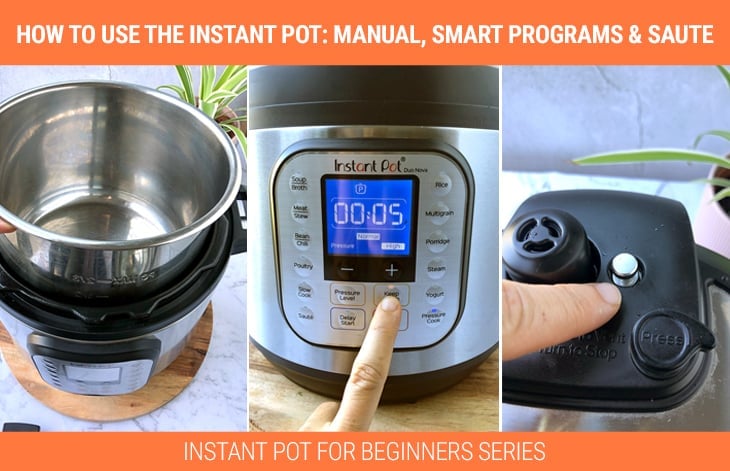
Learn how to use the Instant Pot with step-by-step instructions and photos for manual or smart program pressure cooker settings, how to sauté foods, and how and when to select a natural release or quick release options. Plus, we cover some Instant Pot FAQs and general tips to make your learning curve as the Instant Pot for beginners less steep. Let's get started!

Looking at your shiny new Instant Pot box and wondering where to start? Don’t panic! This wonderful kitchen gadget might seem intimidating but it’s actually very friendly once you get to know it. Let’s unpack the box, it’s time to learn how to use the Instant Pot.
As part of our Instant Pot For Beginner series, we have also covered what the Instant Pot is and how it works with its key features and cooking stages. Make sure to check them out!
As we discussed in this post, there are three key phases to cooking in the Instant Pot. Once you add all ingredients and liquids, secure and lock the lid, and choose your setting and time, the following things happen:
There are other cooking functions that don’t use pressure. Sauté is simply cooking in the pot using the heating that comes from the element in the bottom of the cooker base. It’s just like putting a pot on a stove. You can use it alone or in combination with pressure cooking, such as when you need to brown the meat or onions first.
Slow Cook works in the same way as a regular crockpot. The pot uses controlled gradual heat provided by the heating element in the cooker base. The food cooks on a lower heat for a longer period of time but it’s hand-off and suits certain types of dishes. We will have a more detailed post on how to use the Instant Pot as a slow cooker soon.
Step 1. Place the Instant Pot on a sturdy countertop or a table close to a power socket. Make sure there is plenty of open space above the pot as you will have steam eject from the lid up in the air if you quick release the pressure.
Step 2. Make sure the inner pot is inside the cooker base and is clean. Plug the power cord in. Instant Pot will switch on and the OFF status symbol will appear on the control panel. This is called a standby mode.
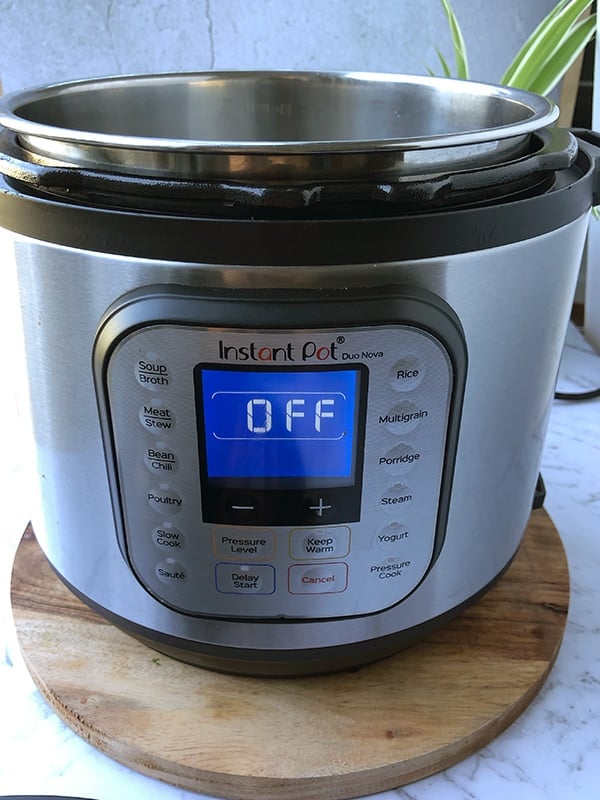
Step 3. Decide on which cooking method you want to use from the below scenarios. This will depend on what you want to cook. Usually, recipe instructions will guide you along here.
In general, your choices will come down to whether you want to Sauté food first and then whether you want to use a manual setting or one of the smart programs.
Before we continue, we must mention the most important aspect of pressure cooking. It requires liquid. This is because the pressure is built by the steam accumulating inside the pot, which is produced from the liquid.
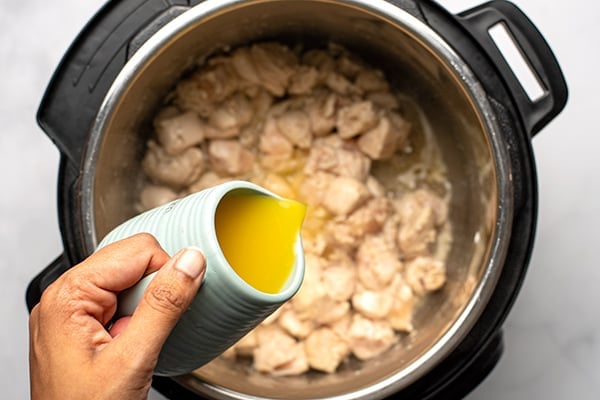
Whether you’re cooking rice, chicken breasts, pot roast, carrots, stew or cheesecake, you will need at least a cup of liquid for the Instant Pot to do its job.
This is a total amount of liquid and can be in the form of water, stock, tomato sauce, juice, wine and liquids released from the food while cooking (e.g. from frozen veggies, from mushrooms, meat juices etc), or a combination of those. The amount of liquid required varies depending on the recipe and amount of food but as a rule of thumb, 1 cup is always a good starting point. Also, the food doesn't need to be completely covered or submerged in liquid to cook.
To explain steps and functions, we are using the Instant Pot Duo Nova 6-quart model, which is recommended for beginners. This info is easily applicable to all other models.
Many Instant Pot users almost always use manual settings. While Smart Program buttons are handy, cooking instructions can vary for different types of rice, smaller or larger beans, and soup with or without meat. With manual settings, you have more control over the time and pressure level. Here is how to use the Instant Pot with manual pressure cooker settings.
Step 1. Star the Instant Pot as mentioned above.
Step 2. Add food, seasoning and liquid to the pot. The liquid can be cold or hot; hotter liquids take less time to heat up so the Instant Pot comes to pressure quicker. Stir if needed.
Note on stirring: If adding tomato sauce or paste, keep them on the top and don’t stir too much as these foods can sometimes thicken and burn during cooking; again, this depends if water and stock are also added as when diluted, it's less of a problem.
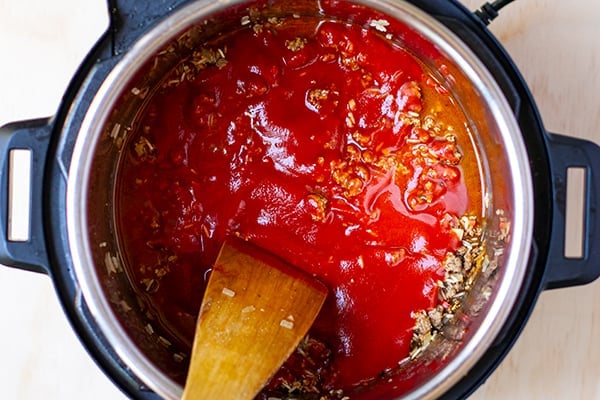
Step 3. Get your lid and quickly check that the sealing ring on the inside is in place. If it’s loose or sticks out, the pot might not seal properly and it will not be able to come to pressure. Place it on top and twist it until it locks in place.
Step 4. On older models like Duo Classic, check that the steam release handle on top of the lid is pointing to Sealing. On the more advanced models of the Instant Pot, the vent will automatically seal when the cooking process begins. On the Duo Nova (below) the quick release button should be popped up and not pressed down.
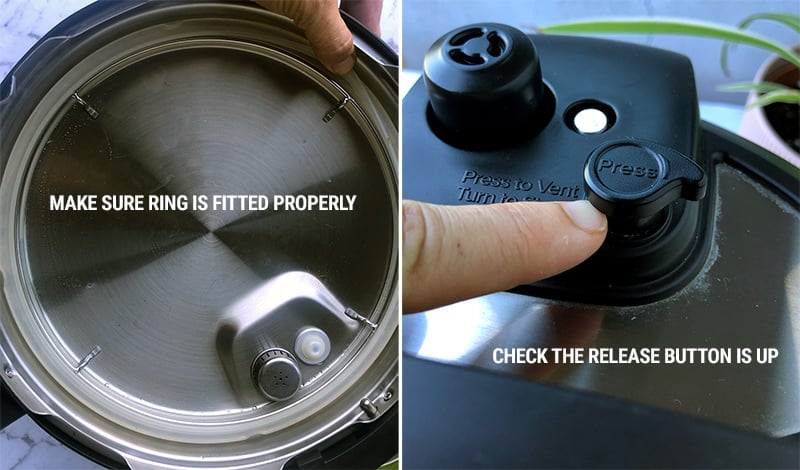
Step 5. Press the Pressure Cook button (Manual on older models). This will bring up a timer in the middle of the control panel (in HH: MM). Use the Pressure Level button to select LOW or HIGH. Most of the time, you will leave it on HIGH.
Step 6. Using - and + buttons, adjust the timer to suit your recipe/food. Let’s say it’s 5 minutes for long-grain rice.
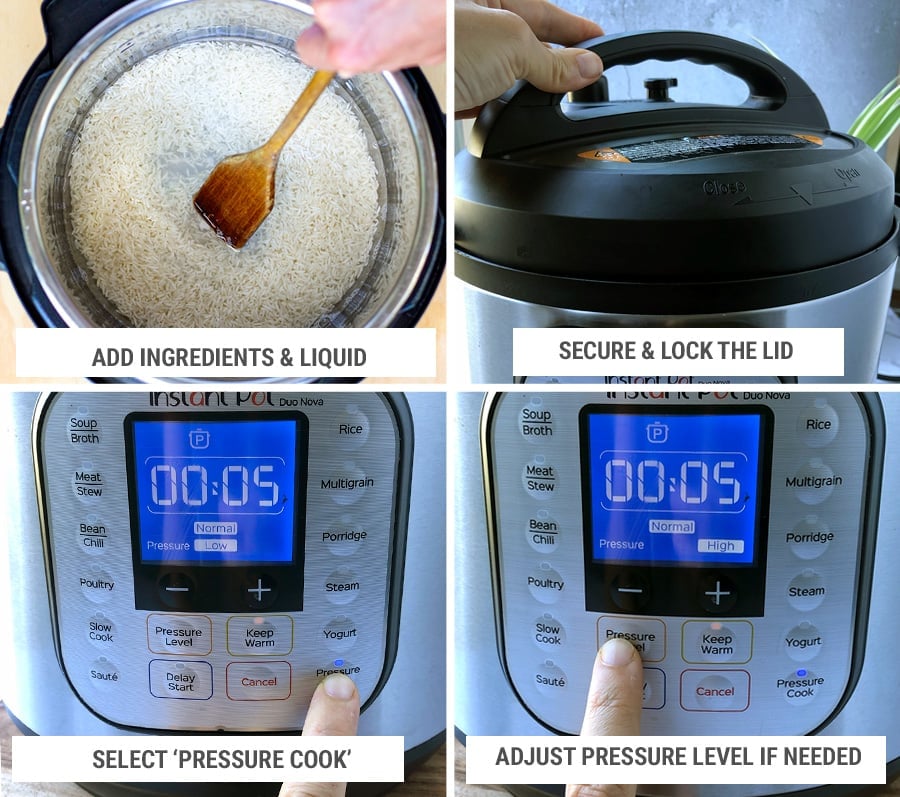
Step 7. By default, the Keep Warm cycle will be selected. This means, that once the dish is finished cooking, the Instant Pot will stay warm for up to 10 hours unless you cancel it at the end. Let's press it to switch it off (note: having it off will speed up the depressurizing stage).
Step 8. Preheating & pressurizing stage beings. After a few seconds, you will hear 3 beeps and the control panel will display On. Two status icons will appear at the top: Heating Up (little pot with fire) & Pressure Cooking (P).
It might seem like nothing is happening but the pressure is building up and after some time you may hear a hissing sound, which should only last for a minute or two. This is normal. Once the pot has come to pressure, the float valve on top of the lid will rise to the top.
Step 9. After a short period, the cooking timer will start counting down. In our case, it will be 5 minutes of cooking the rice under full pressure. The status icons will change to just P - cooking under pressure.
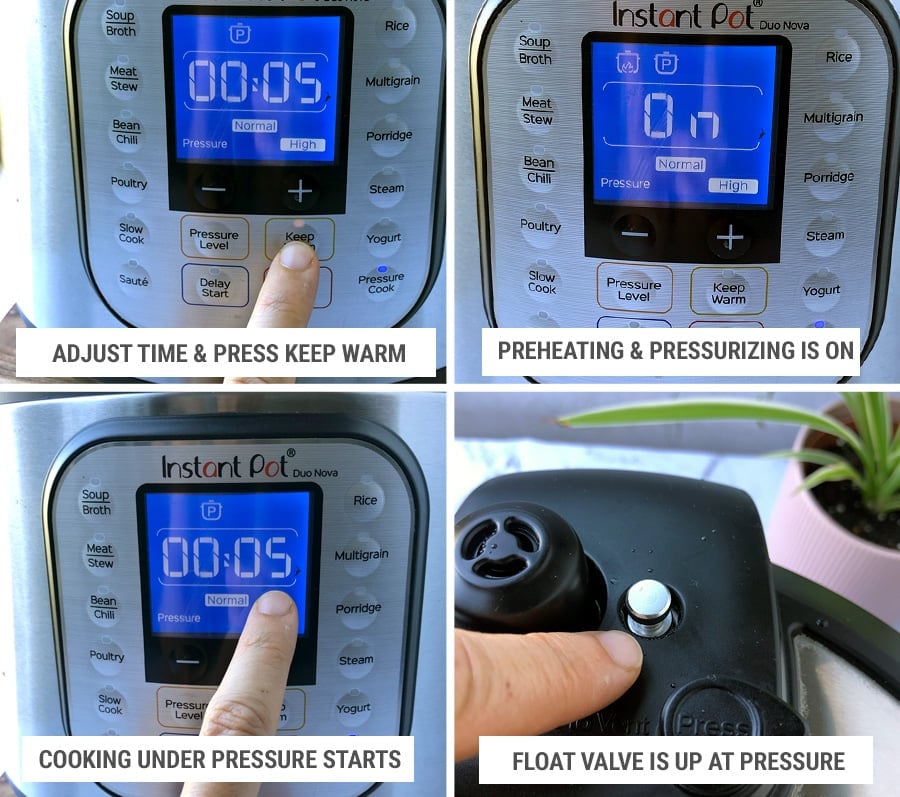
Step 10. Once the Instant Pot beeps again and the timer has reached zero, the cooking process is done. End will appear on the control panel. If you had Keep Warm selected, a new status icon will appear on the display - Keeping Warm - as well as the keeping warm cycle timer, which will last for up to 10 hours unless you press Cancel.
Step 10. You can do a quick release (QR) or allow the built-up pressure and steam to release naturally (NPR).
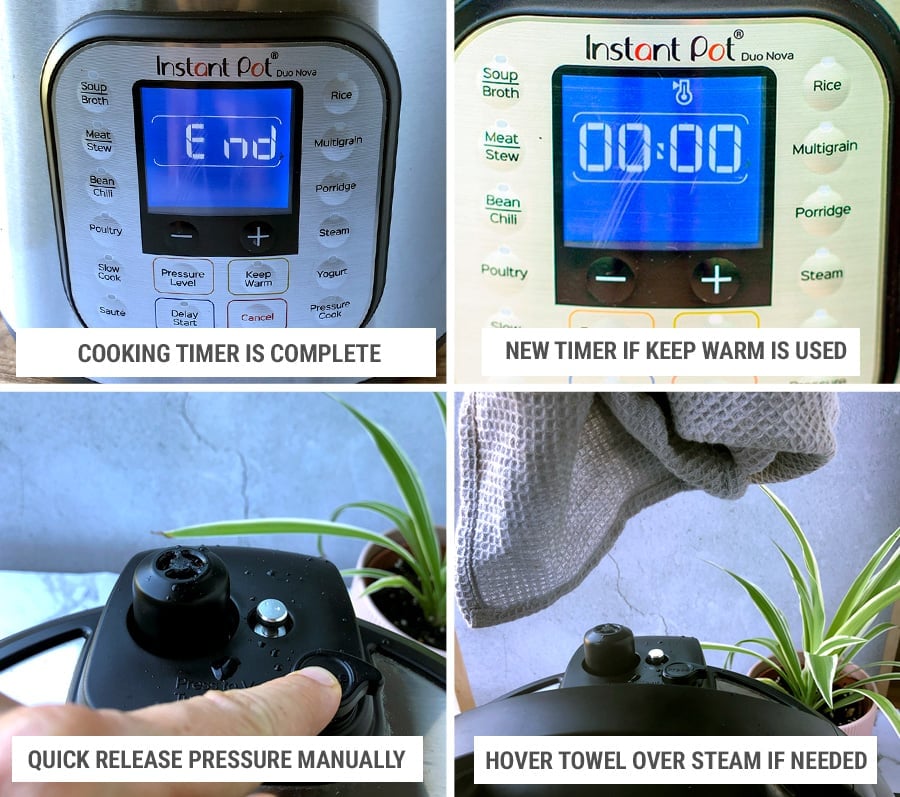
Simply leave it undisturbed! It will release all the steam and pressure by itself after a period of time (anywhere between 10-25 minutes). Once the pressure is released, the float valve on the top will drop back down and the lid will loosen up allowing you to open it. Please note, the food continues to cook at a slower rate during the natural release.
This method will let out the steam in one go and depressurize the pot immediately. This will prevent any continued cooking and is useful if you’re in a rush. Simply press the quick release button on top of the lid (or point the steam release handle on older models to Venting). The steam will rise through the top steam valve and a loud venting or hissing sound will occur.
Yes – that steam is hot and so take care. Be quick to remove your hand once you’ve pressed the button (you can hold a towel while doing this) and step away from the cooker. In some cases, you can hover a towel over the steam jet absorbing some of the moisture and reducing the amount of output you’re exposed to.
Done cooking? Open the lid and stir the contents if needed. Once the pot is empty, remove the inner pot and add some water to soak before cleaning by hand or in a dishwasher. Unplug or switch off the main power to turn the Instant Pot completely off.
This really depends on the food you're cooking (starch, vegetables, beans or meat), the amount of liquid used and the recipe you're following.
This method is great for quickly stopping the cooking process to prevent overcooking.
Use it for:
Avoid using:
Since the pressure is gradually released, there is less movement in the Instant Pot, any built-up foam settles, the stocks and soups come out cleaner and foods are more likely to stay intact.
Use it for:
Avoid using:
Combined NPR and quick release: in many cases, you might want to use both methods for best results; you can allow the pressure to release naturally for 5 minutes and then use the quick release method. This works well for foods like rice, pasta, some soups and porridge.
If you choose to use one of the pre-set smart program options, the steps are even simpler. Please refer to our post on Smart Program Instant Pot Buttons Explained for how to adjust each setting.
Step 1. Start the Instant Pot. Insert the inner pot into the cooker base.
Step 2. Add ingredients and liquids to the inner pot. Stir if needed or leave layered.
Step 3. Secure and lock the lid. Make sure everything feels well sealed.
Step 4. Select one of the Smart Program buttons. Pre-set cooking time and pressure level will display. You can leave it as is or adjust things like the pressure level from HIGH to LOW. You can press the Smart Program button again to cycle through the Less, Normal and More time options or use the - and + buttons to adjust the cooking time further. If you make any adjustments to the selected Smart Program, they will be remembered next time you use it.
Step 5. Preheating & pressurizing stage begins followed by cooking under pressure as per program settings. Once the Instant Pot beeps again and the timer has reached zero, the cooking process is done.
Step 6. You can do a quick release or allow the built-up pressure to release naturally (NPR), or do both depending on the food/recipe.
Step 10. Once pressure is released, open the lid and stir or remove the contents.
Sauté is a non-pressure cooking program that can be used in place of a frying pan or flat-top grill. For recipes that call for browned onions or garlic, it’s important to sauté them before adding liquid to the pot as you will release a lot of flavor this way.
Another reason to sauté first is for browning meat. Lastly, sautéeing before cooking is a great way to increase heat and reduce the amount of time your pot will take to come to pressure. Learn more about other smart program settings on Instant Pot here.
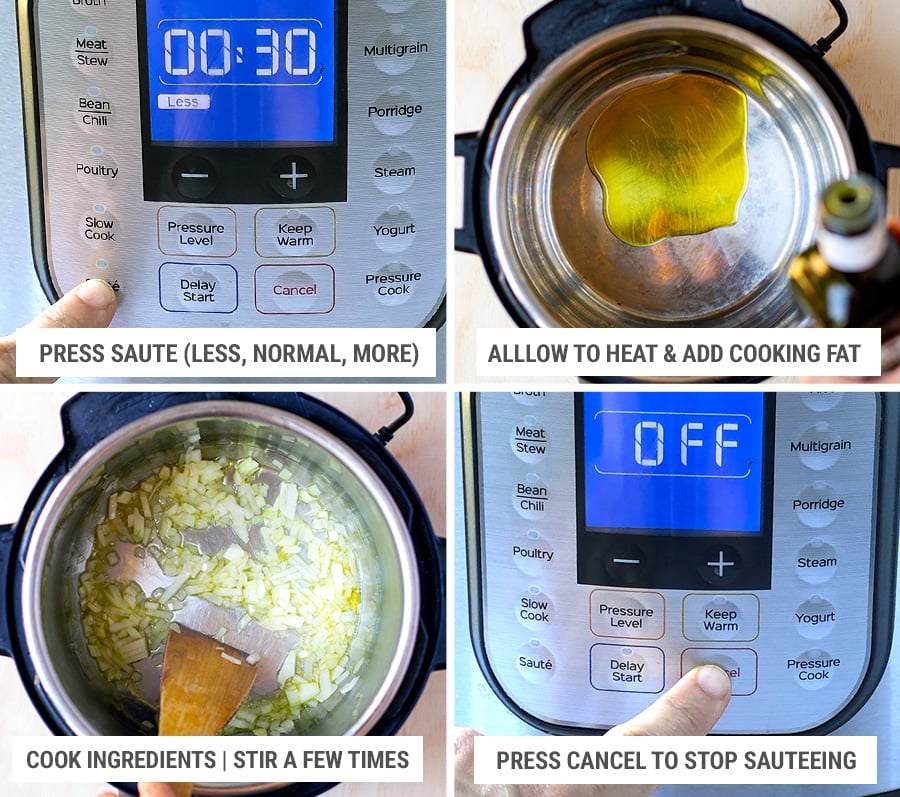
Step 1. Star the Instant Pot. Insert the inner pot into the cooker base. Do not use the lid for the next step.
Step 2. Press the Sauté button. After 10 seconds, the cooker displays ON to indicate that it has begun heating. When display switches from On to Hot, add ingredients you want to brown. Note: You can add ingredients before the Hot message appears; if you do, it may not appear at all. This is normal.
The control panel will display a 30-minute countdown timer as a maximum Sauté time, you can use it for reference if you like or disregard it.
The default temperature setting for Sauté function is Normal. Press Sauté again to cycle through for Less and More temperature options. Use Normal for general pan searing or sautéing, Less for simmering, thickening and reducing liquids and More for Stir-frying or browning meat.
Step 3. Press Cancel to stop the Sauté process. It is recommended to deglaze the inner pot to ensure food items do not scorch during pressure cooking. To deglaze, add some liquid (e.g., water, broth, wine) to the hot pot. Use a wooden or silicone scraper to loosen anything that may be stuck to the bottom of the inner pot. If you brown meat, remove it from the pot first.
Step 4. Add any other ingredients and liquids. Stir if needed or leave layered and continue with the manual or program settings to pressure cook the food.
The Sauté function is also useful for finishing the dish after pressure cooking is done. Once the pressure has been completely released, open the lid and then press Sauté button again. Press the button again to cycle through Less or More for lower or higher temperatures.
Use it for:
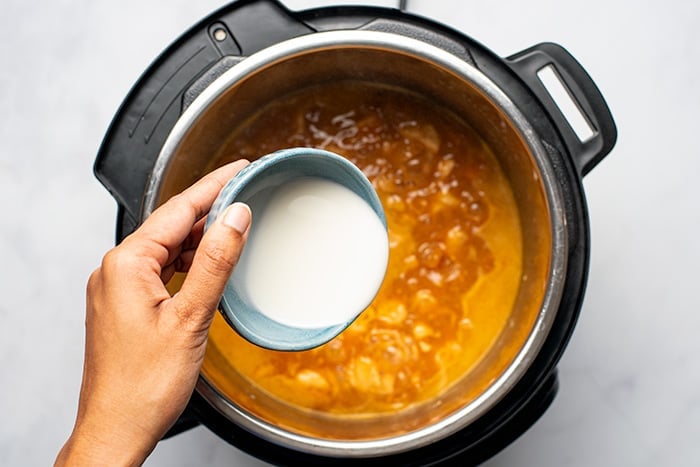
Low pressure should be used for delicate foods like eggs, fish, and vegetables. However, all of these foods can also be cooked using high pressure for a reduced amount of time. If you are confused about whether or not to use low or high pressure, it’s best to stick to high pressure. This should be specified in recipes.
The trivet comes with the Instant Pot. This is a simple insert that allows you to get some space between the bottom of the pot and whatever food you’re cooking. Generally speaking, any food that you might want to cook without having it come into direct contact with liquid can be made more easily with the trivet. You can place the food directly on top of the trivet or add it to around heat-proof casserole dish or cake pan and place that on top of the trivet.
Think of things like chicken breasts, lasagna, breads, meatloaf, and other things that wouldn’t taste great if they were super soggy. It’s also commonly used for eggs, veggies, potatoes, or pot-in-pot cooking. Using the trivet can prevent burning or overcooking and also ensure even cooking.
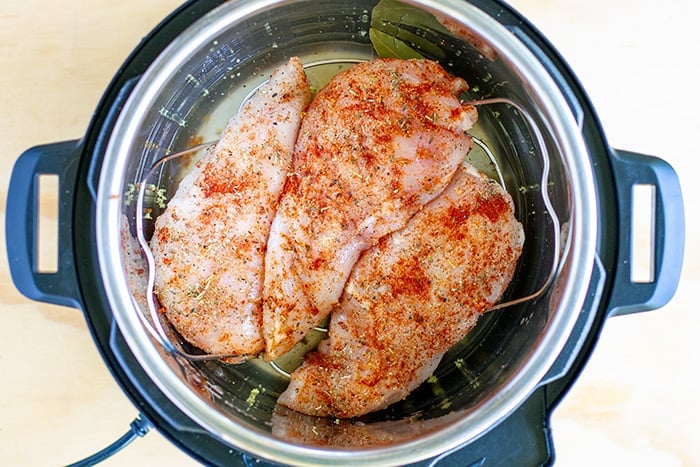 What to use trivet for in Instant Pot" width="700" height="467" />
What to use trivet for in Instant Pot" width="700" height="467" />
The Instant Pot can be kept on ‘Keep Warm’ after cooking most foods. In fact, it’s very handy if you are finished cooking before you’re ready to serve food. Some foods like rice, quinoa, or anything that has soaked up a lot of liquid should be monitored or warmed in a more moist environment to prevent dryness or burning. You can select Keep Warm cycle before you start cooking or after.
One size does not fit all in most scenarios. This is true of the smart one-touch buttons on the Instant Pot too. While some may come in handy down the line, you should learn more about specific recipes before you begin relying on them. Using Manual/Pressure Cook button and adjusting time and pressure level by yourself gives you more control.
Having said that, you can also adjust time and pressure levels once you've selected one of the Smart Program functions.
Yes, technically, because the cooker will take a longer time to come to full high pressure. But using low pressure to save time will not work as certain foods won’t be sufficiently cooked. High pressure is the default cooking setting for most recipes.
Some models have a button that reads ‘Timer’. While you may think that this is the button that sets the cooking time for your Instant Pot, it actually delays cooking time and will start the cooking when the timer counts down. You can set the cooking time with the plus/minus buttons or the dial, depending on the model.
The short answer is yes. Some Instant Pot models e.g. Ultra and MAX will allow you to set your altitude and the cooking times will be automatically adjusted for you. Otherwise, cooking should be adjusted 5% for every 1,000 feet above 2,000 ft. above sea level.
So, for example, at 3,000 ft., you will increase cooking time by 5% and at 4,000 ft., you will increase cooking time by 10% and so forth. One of our team members has lived at many varying high elevations and personally, I have never run into altitude-related issues with my Duo model.
Now that we've covered step-by-step instructions for how to use the Instant Pot manually, with smart programs and to saute food, we wanted to share a few general tips that will help every Instant Pot beginner to master and enjoy pressure cooking without getting overwhelmed or intimidated.
When surveying Instant Pot users, those who felt confident going into cooking with their new gadget had read the manual. Understandably, some people learn better with a hands-on approach and can easily “wing it.” But, a little research before you begin can go a long way.
Many people complain that it’s not the friendliest manual or that it lacks detail to fully understand certain concepts or functionalities. That’s why we created our Instant Pot For Beginners series - to fill in the missing pieces.
For more detailed instructions and information that is still super friendly and easily digestible, we recommend you check out the following posts:
This simple test is really just about boiling water in your Instant Pot. It might seem like an unnecessarily complicated way to boil water BUT it will help you become familiar with the buttons, functions, and safety mechanisms of the Instant Pot without using or wasting any food. It’s kind of like a no-commitment date.
The water test is very easy and you can find instructions in the manual or follow our steps in this post.
Your first recipes shouldn’t be too complicated. Set yourself up for success by beginning with easier dishes so you can develop a more intuitive sense for pressure cooking as you go. Some of the simplest (and useful) Instant Pot recipes for beginners include those using a single ingredient or just a handful of foods and steps, such as:
When we surveyed our readers about their initial experience with the Instant Pot, many users had the advice to just have fun with the pressure cooker! Set aside any expectations, know the Instant Pot is an exceptionally safe kitchen device, and try something new. Even if it doesn’t go according to plan, it should boost your confidence.
Over to you! Do you have any further questions about how to use the Instant Pot as a beginner? What foods or recipes do you plan to cook first? Anything else we can help you with? Leave your feedback and comment below!